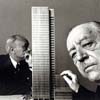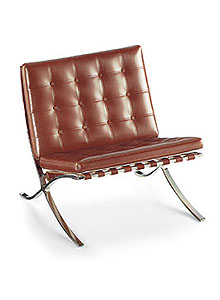 Ludwig Mies van der Rohe
Ludwig Mies van der Rohe
Ludwig Mies van der Rohe (b. 1886), Germany.Ludwig Mies van der Rohe Biography:From all the architects & designers we admire at Stardust, Mies holds a very special place. Ludwig Mies van der Rohe (1886-1969), was a German-born architect and educator. He is widely acknowledged as one of the 20th century's greatest architects. He was the leading and most influential exponent of the refined minimalist glass-and-steel architecture of the mid-20th-century.By emphasizing open space and revealing the industrial materials used in construction, he helped define modern architecture. Regarded as one of the most important figures in the history of architecture, Ludwig Mies van der Rohe's "less-is-more" approach to design was the gold standard for many generations of modern architecture. His legendary career started humbly at his father's stonemasonry business, giving him an early appreciation of material and structure. From there he apprenticed with furniture designer Bruno Paul in Berlin before joining the office of Peter Behrens, an architect and painter at the forefront of the modern movement. In 1912, Mies established his own office in Berlin. Through furniture, residential projects and extraordinary, yet unrealized concepts for skyscrapers, he gained recognition as a leader of the German modern movement. As such, he was selected to design the German Pavilion at the Barcelona Industrial Exposition of 1929. His design, a rhythmic arrangement of horizontal and vertical planes of glass, stone and metal was an experiment in free flowing space. With no discernable distinction between rooms or inside and outside, the design fundamentally challenged the architectural ‘boxes within a box' standard of the time. Inside, Mies included the Barcelona Chair and Ottoman, designed to offer the King and Queen of Spain to a place to rest (they in fact never sat down). The Barcelona Pavilion and the chairs it contained are universally recognized as milestones of modern design. Mies served as Vice President of the Deutsher Werkbund and Director of the Bauhaus from 1930 until it closed in 1933. He immigrated to the United States in 1938 to become the director of architecture at the Armour Institute (later the Illinois Institute of Technology). From his Chicago-based practice, Mies designed a portfolio of buildings that changed the face of American institutional architecture ― the most notable examples being the IIT campus and the Seagram Building in New York. While at IIT he befriended and mentored a young Florence Knoll. Florence has always credited Mies as her most influential instructor, and, in 1948, Mies granted Knoll exclusive rights to produce his furniture, including the Barcelona collection, the Brno chair, and MR series. Ludwig Mies van der Rohe Architecture:Like his contemporaries Walter Gropius and Le Corbusier, Mies championed simplicity in the cause of a truly Modern architecture, eschewing decorative elements in favor of clarity and emphasizing functionality as absolutely central to any structure's aesthetic appeal. Our built environment is meant to be lived in. Mies' buildings, beyond merely affecting our lives, endow them with greater significance and beauty. His buildings radiate the confidence, rationality, and elegance of their creator and, free of ornamentation and excess, confess the essential elements of our lives. In our time, where there is no limit to excess, Mies' reductionist approach is as pertinent as ever. As we reduce the distractions and focus on the essential elements of our environment and ourselves, we find they are great, intricate, and beautiful. Less is more. Mies van der Rohe's severely geometric, unembellished buildings have been designed to express in purest forms a technological concept of the middle of the 20th century but they endure because they are timeless. Believing that less is more, Mies van der Rohe designed rational, minimalist houses and buildings that set the standard for modernist design. Some of his best known examples include the Barcelona Pavilion, the Farnsworth House, the Seagram Building, Villa Tugendhat, S.R. Crown Hall, the 860-880 Lake Shore Drive Apartments, the Weissenhof Estate, 330 North Wabash, Haus Lange and Haus Esters, the Martin Luther King Jr. Memorial Library, One Charles Center, Lafayette Pavilion Apartments, Promontory Apartments, the Riehl House, the Lemke House, Urbig House and many others. Each Mies van der Rohe architectural masterpiece, be it a large apartment building or private residence expresses the simplicity and sturdy nobility of Mies himself.Ludwig Mies van der Rohe Farnsworth House:The Farnsworth House is one of the most iconic examples of modernist architecture of the 20th century (along with Richard Neutra's Kaufmann Desert House). The architecture of the Farnsworth House represents the ultimate refinement of Mies van der Rohe's minimalist expression of structure and space. It is composed of three strong, horizontal steel forms - the terrace, the floor of the house, and the roof - attached to attenuated, steel flange columns. The Farnsworth House is one of the most significant of Mies van der Rohe's works, equal in importance to such canonical monuments as the Barcelona Pavilion, built for the 1929 International Exposition and the 1954-58 Seagram Building in New York. Its significance is two-fold. First, as one of a long series of house projects, the Farnsworth House embodies a certain aesthetic culmination in Mies van der Rohe's experiment with this building type. Second, the house is perhaps the fullest expression of modernist ideals that had begun in Europe, but which were consummated in Plano, Illinois. In many ways also, Mies van der Rohe was able to realize spatial and structural ideals that were impossible in larger projects, such as the Seagram Building. For example, the I-beams of the Farnsworth House are both structural and expressive, whereas in the Seagram Building they are attached to exterior as symbols for what is necessarily invisible behind fireproof cladding. In addition, the one-story Farnsworth house with its isolated site allowed a degree of transparency and simplicity impossible in the larger, more urban projects. The significance of the Farnsworth House was recognized even before it was built. In 1947 a model of the Farnsworth House was exhibited at the Museum of Modern Art in New York. Describing it, along with the unbuilt Resor House, as a “radical departure from his last European domestic projects,” Philip Johnson noted that it went further than the Resor house in its expression of the floating volume: “The Farnsworth house with its continuous glass walls is an even simpler interpretation of an idea. Here the purity of the cage is undisturbed. Neither the steel columns from which it is suspended nor the independent floating terrace break the taut skin.” In the actual construction, the aesthetic idea was progressively refined and developed through the choices of materials, colors and details. While subsequent debates and lawsuits sometimes questioned the practicality and livability of its design, the Farnsworth House would increasingly be considered, by architects and scholars alike, to constitute one of the crystallizing and pivotal moments of Mies van der Rohe's long artistic career"Romanticists don't like my buildings. They say my designs are cold and rigid. But we do not build for fun. We build for a purpose." - Mies van der Rohe Ludwig Mies van der Rohe Furniture:Mies van der Rohe is one of those titans of international design, a name instantly recognizable to any fan of 20th century architecture and furniture design. His furniture and buildings brought him instant and constant acclaim during his lifetime, and his work has only grown in stature and importance since its long-ago debut. Much of van der Rohe's work was done in conjunction with the Knoll Furniture company, the home of some of the very finest interior design anywhere in the world, and a veritable stable of internationally renowned designers and stylists who called it their manufacturing and distribution center. Though Mies van der Rohe designed his furniture almost 90 years ago, it's every bit as fresh and bold as the latest and greatest in interior design. One of these Mies van der Rohe furniture classics is his Barcelona Chair. One of the most recognized objects of the last century, and an icon of the modern movement, the Barcelona Chair is a tribute to the marriage of design and craftsmanship.Ludwig Mies van der Rohe Quotes:Less is More.God is in the details. I don't want to be interesting. I want to be good. It is better to be good than to be original. Architecture is the will of an epoch translated into space. No design is possible until the materials with which you design are completely understood. Architecture starts when you carefully put two bricks together. There it begins. A chair is a very difficult object. A skyscraper is almost easier. That is why Chippendale is famous. True education is concerned not only with practical goals but also with values. Our aims assure us of our material life, our values make possible our spiritual life. Ludwig Mies van der Rohe Sale at Stardust:Shop Ludwig Mies van der Rohe design at Stardust & receive Free Shipping and a 100% Low Price Match Guarantee. Stardust; the best design shop in town™, buy modern home furnishings and designer lighting! |


